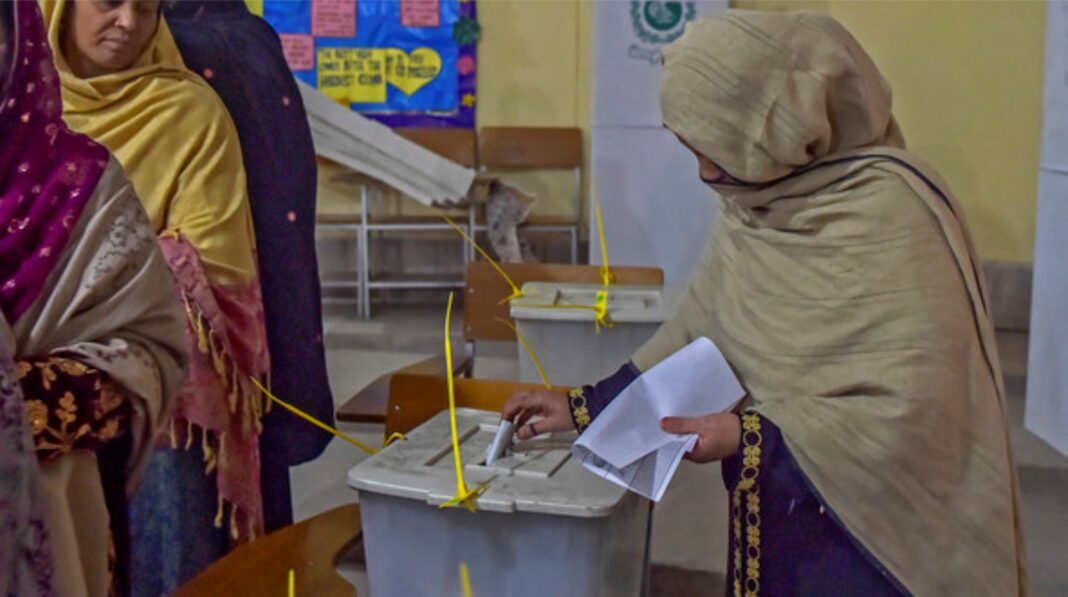Low female turnout and vote secrecy issues persist in PK-7 Swat-VI By-Election, Free and Fair Election Network says in its report.
Abysmally low female turnout and inadequate arrangements to protect secrecy of vote coupled with widespread instances of campaigning and canvassing on Election Day remain major issues clouding the by-election in PK-7 Swat-VI that was otherwise peaceful with generally compliant voting and counting processes, observes Free and Fair Election Network in its report.
Only 6,020 (six percent) of the 84,339 registered female voters exercised their right to vote in the by-election held on June 26, 2022. Of 28 female polling stations, 22 recorded less than 10 percent turnout with the lowest remaining one percent at Polling Stations No. 51 and 119.
Low Female Turnout: What Does Law Say?
The votes polled by female voters in the constituency, however, made up 18 percent of the total polled votes. Under section 9(1) of the Elections Act, 2017, if the turnout of women voters is less than 10 percent of the total votes polled in a constituency, the Election Commission may presume that the women voters have been restrained through an agreement from casting their votes and may declare, polling at one or more polling stations or election in the whole constituency, void
Overall, 33,573 (18 percent) registered voters turned out to vote in the by-election. The constituency had recorded 37 percent turnout – 51 percent male and 18 percent female in General Election (GE) 2018 and 23 percent turnout – 33 percent male and 10 percent female – in by-election held in October 2018. There were three female polling stations with less than 10 percent turnout in GE-2018 and 21 in by-election 2018. The persistent low women turnout in the constituency necessitates targeted and urgent measures by the Election Commission to encourage women to vote during future elections.
Procedurally, the by-election witnessed irregularities mainly relating to secrecy of vote and campaigning and canvassing inside and around polling stations. According to FAFEN observers, 52 (29 percent) of 180 observed polling booths had secrecy screens installed in such a manner that might have compromised voter’s secrecy. In addition, 13 polling booths had CCTV cameras angled toward the portion of booth reserved for marking of ballot papers by voters.
Low Female Turnout Out & Distribution of Campaign Material
The campaigning irregularities also persisted in the recent by-election. A majority of the observed polling stations (59 or 80 percent) had party camps in their legally-prohibited surroundings, while more than a third of those were actively involved in distributing campaign materials to potential voters. FAFEN observers also witnessed the presence of campaign materials of contesting parties or candidates inside 14 (19 percent) observed polling stations.
The voting process was reported to be orderly and peaceful across the observed polling stations. The polling staff was present at all observed polling stations while the election materials were also available in adequate quantities. The Assistant Presiding Officers (APOs) and Polling Officers (POs) were duly completing all legal and regulatory requirements for voter identification and ballot issuance. FAFEN observers, however, reported 16 instances of voters being turned away from polling stations as their names were not on the electoral rolls of the station they were visiting.
The counting process was also compliant with the due procedural and legal requirements; however, the observers reported issues concerning the transparency of polling station results. The Presiding Officers did not paste Form-45 (Result of the Count) outside nine (50 percent) of the polling stations where counting was observed. Similarly, Form-46 (Ballot Paper Account) was not pasted in 11 (61 percent) instances.
For 188,084 registered voters in the constituency, the ECP had set up 124 polling stations, assigning more than 1,200 voters to 98 (79 percent) polling stations, which is a legally recommended limit of voters assigned to a polling station.
Political Parties & Candidates
Three political parties i.e. Pakistan Tehreek-e-Insaf (PTI), Awami National Party (ANP) and Tehreek-e-Inqlab Siyasi Tehreek (TIST) fielded their candidates for PK-7 Swat-VI by-election while one candidate ran independently. According to Form-47 (Provisional Consolidated Statement of Results of the Count), PTI’s candidate Fazal Moula won the by-election securing 17,395 (52 percent) polled votes while ANP’s Hussain Ahmed Khan remained runner up with 14,604 (44 percent) votes. Moreover, two percent (770) of the polled votes were excluded from the count.
During the General Election 2018, PTI’s candidate Mr. Amjad Ali had won this constituency while the ANP’s Waqar Ahmed Khan remained the runner-up. However, Mr. Ali vacated the seat to retain another seat that he had won. Former runner-up Mr. Ahmed won the seat in the by-election held on October 14, 2018 defeating PTI’s candidate Fazal Moula. The seat fell vacant again due to the death of Mr. Waqar Ahmed Khan on April 30, 2022 necessitating a second by-election in the constituency.
FAFEN had deployed a total of 19 non-partisan and trained observers including 12 men, six women and one transgender. These observers were allowed to observe the voting process at 74 polling stations and counting processes at 18 polling stations. FAFEN observers were duly accredited by the Election Commission of Pakistan in compliance with the requirements of section 238 of the Elections Act, 2017.
To download the report, click here


